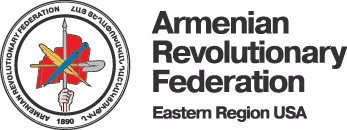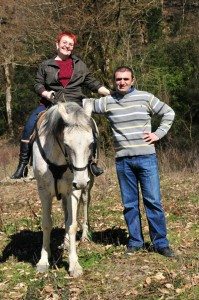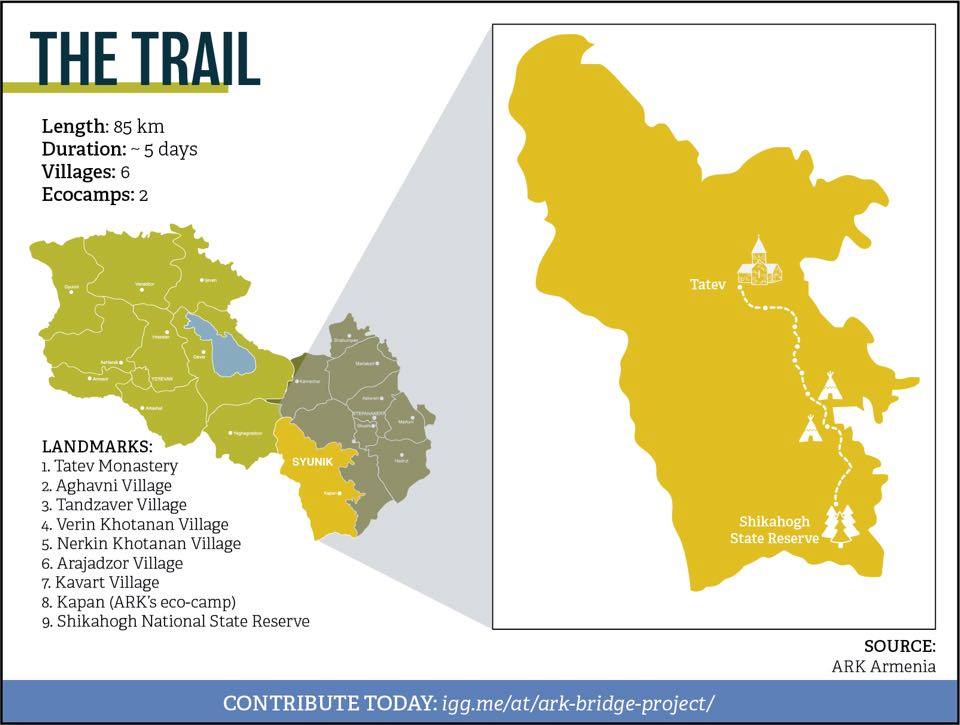Southern Armenia and ARK

Special for the Armenian Weekly
Last year I had the great pleasure of living in Kapan for a month while I was consulting for a project in the Zangezur Biosphere Complex in Southern Syunik, Armenia. It was my first time in Kapan and I was excited to explore the area. I went to Southern Syunik with three common preconceptions that many share about the region:
– There is a lot of mining in this area;
– Armenia’s second largest forest reserve, the Shikahogh Reserve, is located here and there is a high level of biodiversity; and
– This part of Armenia is sorely underexplored
I also knew that there was a local organization based in Kapan, the ARK Ecological NGO (ARK Armenia), that is trying to increase tourism to the area by building hiking and camping infrastructure. I was intrigued to learn more about them. Oscar Alvarado, ARK Armenia’s environmental coordinator, had reached out to my organization, the Armenian Environmental Network (AEN), months earlier to introduce us to their efforts and to collaborate.
While I was in Kapan, I visited the ARK Armenia office and met with its founders, Armen Kazaryan and Siranush Vardanyan. I was instantly impressed with their passion and commitment to raising awareness about the area and increasing tourism. It’s rare and refreshing to find such vision, drive, and optimism in Armenia, especially outside of Yerevan.
I visited ARK’s eco-camp, a modest yet totally sufficient camp with three two-story bungalows, a bathroom, shower, kitchen with a gas stove, and electricity. Kazaryan described to me his plans for an organic permaculture garden. The camp is a 15-minute walk from the heart of Kapan but has great views of Kapan and the majestic Khustup Mountain.
I also went for some hikes while in Southern Syunik and can attest to the breathtaking beauty and biodiversity in the area. As an environmentalist and outdoor enthusiast, I was excited not only about the efforts to increase accessibility to and awareness of this area but also about the increased attention on ecotourism in Armenia. As with any development in Armenia, it’s critical that it be sustainable, which ARK Armenia is committed to. It’s exciting to think how increased ecotourism to this neglected part of Armenia could help the residents who live in the remote villages there, and could increase awareness about the value of this area and the importance of conserving it.
I recently interviewed Alvarado about ARK Armenia to find out more about them and their current ARK Bridge Project.
Serda Ozbenian: When and why was ARK Ecological NGO founded?
Oscar Alvarado: Having returned to Armenia in 2013, after spending many years abroad, Armen Kazaryan and Siranush Vardanyan decided to buy a plot just outside Kapan (Armen’s hometown) to realize their ambition of having a place where they could practice organic farming, fitness activities, and also host guests. Soon they found like-minded people, among them Armen Bodoyan who was ARK Armenia’s first supporter, and realized they would rather develop this project in a way that would also benefit the community at large. In autumn 2014, they decided to launch their first crowdfunding campaign to finance the project. Besides raising funds this campaign helped ARK gain recognition in Armenia and beyond, thus attracting volunteers who have always been and still are ARK’s most valuable resource. This is how I joined the ARK team in early 2015.
As we worked on the first eco-camp, we realized the potential of using nature as a valuable resource to start a brand new economic industry in the region, away from traditional industry and mining that one usually associates with Kapan. Thus, in mid-2015 ARK Ecological NGO was officially registered.
S.O.: What is ARK Armenia’s mission and long-term goals in Armenia?
O.A.: ARK Armenia is focused on developing sustainable practices in the region and then sharing this knowledge with the local communities. Under this mission, our strategy is to help shift the Kapan economy away from heavy industry and towards more sustainable activities. Ecotourism is at the forefront of what we do, but we are using our first eco-camp to showcase to the community sustainable practices such as upcycling, organic farming (including permaculture designs), being outdoors, hiking, and an overall healthy lifestyle. ARK Armenia’s activities are concentrated in Syunik, but we are ready to cooperate with other NGO’s to realize our ideas all over Armenia.
S.O.: Briefly describe the ARK Bridge Project and what kind of support is needed.
O.A.: ARK Bridge Project is our latest initiative, the goal of which is to connect the Tatev Monastery, the most popular tourist attraction in Syunik, to Kapan and eventually to the Zangezur Biosphere Complex in Southern Syunik. This will be by means of a hiking trail network, campsites, and a tourism information support system. We have decided to use crowdfunding as a way to finance this project because we believe that when people hear our story, learn about our achievements, and see the benefits of what we’re doing, they will not only donate but join our cause either as a volunteer or as a guest.
S.O.: How have local communities reacted to ARK? What kind of community outreach has been done?
O.A.: We have always had the support of local communities for our projects. We were grateful to have the assistance of local people while creating our hiking trails, as they were most familiar with the routes we wanted to mark.
ARK in turn delivers social services to local communities. ARK’s eco-camp is used for recreation, as well as physical and social rehabilitation. Now we are collecting data from rural inhabitants who can offer products and services to tourists. The database will be on ARK Armenia’s website to be available for eco, agro, and adventure tourists. Rural communities will be the main beneficiaries of the ARK Bridge project.
S.O.: What is ARK’s future vision for Syunik and ecotourism in Armenia?
O.A.: Armenia has an amazing diversity of landscape, flora, and fauna which is the most attractive factor for ecotourists. This is especially true for Syunik, where there is one of the largest forests in Armenia and the greatest change in altitude. With proper marketing and infrastructure, Syunik can be among the top ecotourist destinations in the world and help raise the profile of Armenia even further.
S.O.: Can you talk a little bit about the importance of hiking trails in Armenia (as opposed to just hiking wherever)?
O.A.: Hiking trails are the best way for a traveler to engage with a country’s nature, people, and cultural landmarks. By creating distinct trails, we discourage ad hoc trails that may pass through sensitive natural areas or that lack appropriate information. Our hiking trails, which are marked and mapped, allow travelers to feel comfortable on their hike and lets them explore many of the features that make Kapan unique in Armenian history.
S.O.: Does ARK Armenia follow the “do no harm” principle? What precautions is ARK taking to ensure that visitors and the construction of hiking trails does not harm the environment, wildlife or local communities?
O.A.: Mountains and forests of Syunik are covered with a dense network of historical routes known and used by locals. ARK’s task is not to make new paths through forest by cutting trees, but rather to mark these existing trails and encourage engagement with the local communities that surround them. We ourselves go hiking on these trails often to make sure that no garbage is being left behind and to discuss with locals the effects. Our wish is for local communities to more greatly appreciate the nature that surrounds them if they see international travelers doing the same.
Source: Armenian Weekly Mid-West




